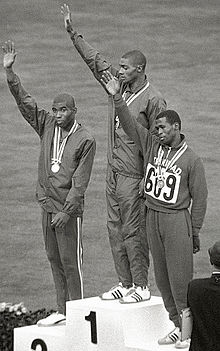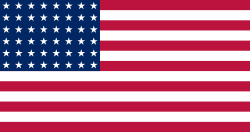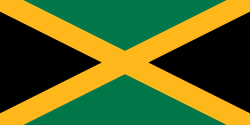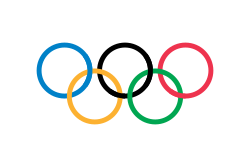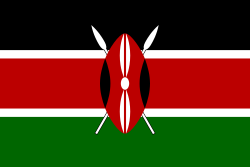Henry Carr
| Henry Carr | ||||||||||
| Nation | ||||||||||
| Geburtstag | 27. November 1941 | |||||||||
| Sterbedatum | 29. Mai 2015 | |||||||||
| Karriere | ||||||||||
|---|---|---|---|---|---|---|---|---|---|---|
| Disziplin | Sprint | |||||||||
| Medaillenspiegel | ||||||||||
| ||||||||||
| ||||||||||
| Henry Carr | |
|---|---|
| Position: Defensive Back | Trikotnummer: 28 |
| geboren am 27. November 1941 in Montgomery, Alabama | |
| gestorben am 29. Mai 2015 in Griffin, Georgia | |
| Karriereinformationen | |
| NFL Draft: 1965 / Runde: 4 / Pick: 43 | |
| AFL Draft: 1965 / Runde: Red Shirt Rd 3 / Pick: 21 (von den Kansas City Chiefs) | |
| College: Arizona State | |
| Teams: | |
| Karrierestatistiken | |
| Interceptions | 7 |
| Touchdowns | 1 |
| Statistiken bei NFL.com | |
| Statistiken bei pro-football-reference.com | |
| Karrierehöhepunkte und Auszeichnungen | |
| |
Henry Joseph Carr (* 27. November 1941[1] in Montgomery, Alabama; † 29. Mai 2015 in Griffin, Georgia)[2][3][4] war ein US-amerikanischer Sprinter und Olympiasieger.
Leichtathletik
Carr war einer der stärksten Läufer in den 1960er Jahren. Bereits in der High School war er ein außerordentlicher Sprinter, bevor er während seiner Studienzeit an der Arizona State University zum Star wurde. Er gewann drei nationale Titel, stellte neue Weltrekorde über 200 Meter, 220 Yards und über 4-mal 440 Yards auf. 1963 gewann er die NCAA-Meisterschaft über 200 Meter und stellte im gleichen Jahr einen neuen Weltrekord über 200 Meter mit 20,4 Sekunden und einen über 220 Yards in 20,3 Sekunden auf. 1964 steigerte er seine Leistungen nochmals und stellte einen neuen Weltrekord über 220 Yards in 20,2 Sekunden auf. In den Jahren 1963 und 1964 führte er über 200 Meter die Weltrangliste an.
Bei den Olympischen Spielen 1964 in Tokio gewann er im 200-Meter-Lauf die Goldmedaille, vor seinem Landsmann Paul Drayton und Edwin Roberts aus Trinidad und Tobago sowie die Mannschaftsgoldmedaille in der 4-mal-400-Meter-Staffel, zusammen mit Ollan Cassell, Mike Larrabee und Ulis Williams, vor den Teams aus dem Vereinigten Königreich und Trinidad und Tobago.
American Football
Nach seiner aktiven Zeit als Sprinter spielte er als Defensive Back American Football für die New York Giants in der National Football League (NFL). Er wurde im NFL Draft 1965 von den Giants in der vierten Runde als 43. Spieler ausgewählt.[5] Zwischen 1965 und 1967 wurde er in 37 Spielen in der Regular Season eingesetzt, lief jedoch nie als Starter auf. Er erzielte einen Touchdown (nach einer Interception).
Privatleben
Carr war verheiratet und hatte zwei Töchter und einen Sohn. Er gehörte der Glaubensgemeinschaft der Zeugen Jehovas an und starb am 29. Mai 2015 im Alter von 73 Jahren an den Folgen einer Krebserkrankung.[4]
Weblinks
- Henry Carr in der Datenbank von Olympedia.org (englisch)
- ASU, Olympic track champion Henry Carr dies at 73
- Profil bei nfl.com (englisch)
- Statistiken im American Football bei pro-football-reference.com (englisch)
Einzelnachweise
- ↑ Henry Carr Obituary. Gedenkseite der Familie Carr auf conner-westburyfuneralhome.com (englisch, abgerufen am 8. Juni 2015).
- ↑ Jeff Metcalfe: ASU, Olympic track champion Henry Carr dies at 73. In: azcentral.com. The Arizona Republic, 2. Juni 2015, abgerufen am 3. Juni 2015 (englisch): „Henry Carr, Arizona State's first Olympic track gold medalist and a member of the National Track & Field Hall of Fame, died of cancer at age 73 in Griffin, Ga.“
- ↑ Henry Carr, track gold medalist, Giants DB, dies at age 73. In: foxsports.com. FOX Sports, 2. Juni 2015, abgerufen am 3. Juni 2015 (englisch): „Henry Carr, an Olympic track gold medalist from Arizona State who went on to play defensive back for the New York Giants, died Friday, May 29, in Griffin, Ga. He was 73.“
- ↑ a b Richard Goldstein: Henry Carr, Gold Medalist and Then a Giant, Dies at 73. In: The New York Times vom 7. Juni 2015 (englisch, abgerufen am 8. Juni 2015).
- ↑ Nick Zaccardi: Henry Carr, 1964 Olympic 200m champion, dies at 72. In: olympictalk.nbcsports.com. NBC, 3. Juni 2015, abgerufen am 3. Juni 2015 (englisch): „Carr was drafted by the New York Giants in the fourth round in 1965 and played three seasons as a defensive back.“
| Personendaten | |
|---|---|
| NAME | Carr, Henry |
| ALTERNATIVNAMEN | Carr, Henry Joseph (vollständiger Name) |
| KURZBESCHREIBUNG | US-amerikanischer Sprinter und Olympiasieger |
| GEBURTSDATUM | 27. November 1941 |
| GEBURTSORT | Montgomery, Alabama, Vereinigte Staaten |
| STERBEDATUM | 29. Mai 2015 |
| STERBEORT | Griffin, Georgia, Vereinigte Staaten |
Auf dieser Seite verwendete Medien
Pictograms of Olympic sports – . This is an unofficial sample picture. Images of official Olympic pictograms for 1948 Summer Olympics and all Summer Olympics since 1964 can be found in corresponding Official Reports.
Autor/Urheber: B1mbo, Lizenz: CC BY-SA 2.5
Zeichnung einer Goldmedaille, basierend auf Olympic rings.svg.
Autor/Urheber: B1mbo, Lizenz: CC BY-SA 2.5
Zeichnung einer Silbermedaille, basierend auf Olympic rings.svg.
Autor/Urheber: B1mbo, Lizenz: CC BY-SA 2.5
Zeichnung einer Bronzemedaille, basierend auf Olympic rings.svg.
Olympic Rings without "rims" (gaps between the rings), As used, eg. in the logos of the 2008 and 2016 Olympics. The colour scheme applied here was specified in 2023 guidelines.
US Flag with 45 stars. In use 4 July 1896–3 July 1908. Created by jacobolus using Adobe Illustrator, and released into the public domain. This flag was used during the Spanish-American War.
US Flag with 45 stars. In use 4 July 1896–3 July 1908. Created by jacobolus using Adobe Illustrator, and released into the public domain. This flag was used during the Spanish-American War.
US Flag with 48 stars. In use for 47 years from July 4, 1912, to July 3, 1959.
The Canadian Red Ensign used between 1921 and 1957.
This image has compared for accuracy (mainly colors) using an image from World Statesmen. The only change is making the maple leaves green from red. This image has compared for accuracy (mainly colors) using an image from World Statesmen. The most recent version of this image has changed the harp into one with a female figure; see [http://flagspot.net/flags/ca-1921.html FOTW
Flag of Italy from 1946 to 2003, when exact colors were specified.
(c) I, Cmapm, CC BY-SA 3.0
The flag of the Soviet Union (1955-1991) using a darker shade of red.

(c) I, Cmapm, CC BY-SA 3.0
The flag of the Soviet Union (1955-1991) using a darker shade of red.

Olympische Flagge
Flag of Canada introduced in 1965, using Pantone colours. This design replaced the Canadian Red Ensign design.
Flagge des Vereinigten Königreichs in der Proportion 3:5, ausschließlich an Land verwendet. Auf See beträgt das richtige Verhältnis 1:2.
Flagge des Vereinigten Königreichs in der Proportion 3:5, ausschließlich an Land verwendet. Auf See beträgt das richtige Verhältnis 1:2.
The American sprinters Henry Carr and Paul Drayton along with Trinidadian sprinter Edwin Roberts greeting with a wave during the 200-metre finals award ceremony at the Tokyo Olympics. Tokyo, October 1964
The Canadian Red Ensign used between 1921 and 1957.
This image has compared for accuracy (mainly colors) using an image from World Statesmen. The only change is making the maple leaves green from red. This image has compared for accuracy (mainly colors) using an image from World Statesmen. The most recent version of this image has changed the harp into one with a female figure; see [http://flagspot.net/flags/ca-1921.html FOTW
